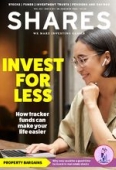Archived article
Please note that tax, investment, pension and ISA rules can change and the information and any views contained in this article may now be inaccurate.
The quick and easy way to build a diversified portfolio using cheap tracker funds

One of the most compelling attributes of exchange-traded funds, also known as ETFs, is they allow investors to create a diversified investment portfolio from scratch rapidly, easily and inexpensively.
If you bought a product tracking the MSCI World index you could arguably do this at the click of a single button – and by doing so you would gain exposure to more than 1,500 stocks. But that index is not enough for a diversified portfolio.
The unpredictability of markets and the fact the large US market dominates global indices means there is a case for having money in a broader spread of geographies and asset classes.
A GOOD STARTING POINT
Let’s build a portfolio using ETFs which might appeal to someone in their 30s and 40s and who doesn’t need the money for at least 10 years.
For purposes of illustration, let’s say you start with a £10,000 pot and choose to put half of that money into developed market shares. You might want to split it £4,000 into an ETF tracking the MSCI World and £1,000 into a FTSE 250 ETF.
While the FTSE 100 is the London’s market’s flagship index, the mid-cap FTSE 250 has more of a domestic focus and has also performed better than its large-cap counterpart over the long term.
This reflects some of the key qualities of mid-cap investments. They typically have more significant growth potential than FTSE 100 firms and are not as widely followed by analysts so there is a greater possibility of them surprising on the upside with earnings, but they are also not as volatile as small caps and are more likely to pay dividends.
WHAT ELSE MIGHT GO IN THE PORTFOLIO?
You could put £2,000 or 20% of the sum into emerging markets stocks, to gain exposure to long-term growth drivers linked to positive demographics – i.e., a large working age population – and an emergent middle class.
That would leave £3,000 to split evenly between other asset classes including bonds, to help cushion some of the volatility of the stock market, commodities and property.
To create our portfolio, we have focused on ETFs which offer low charges (with an average ongoing charge of just 0.15%) and sufficient scale (at least £100 million in assets).
Where possible we have included an accumulation class of ETF, which automatically reinvests any income from underlying investments. This assumes the portfolio is for someone with a long investment horizon who may not need income from their investments in the short term.
SELECTING APPROPRIATE ETFS
There are six constituents in our ETF portfolio – someone looking for a slimmed down, simplified version could consider halving that number by allocating 70% to the MSCI World ETF alone, 20% in the bond product and 10% in the property vehicle.
Lyxor MSCI World ETF (LCWL) £11.29
Ongoing charge: 0.12%
This ETF tracks the performance of more than 1,500 large and mid-cap stocks across 23 developed market countries including Microsoft (MSFT:NASDAQ) and Johnson & Johnson (JNJ:NYSE). On a 10-year view the annualised return from the underlying index is more than 8%.
Vanguard FTSE 250 ETF (VMIG) £33.25
Ongoing charge: 0.1%
This tracks the FTSE 250 index – in effect the 250 next largest companies after the FTSE 100 on London’s Main Market. Its largest allocation is to financials, but it is more diversified than the FTSE 100 with a large exposure to industrials too. Top constituents include mining services specialist Weir (WEIR), renewable energy trust Greencoat UK Wind (UKW) and engineering firm IMI (IMI).
Lyxor MSCI Emerging Markets ETF (LEMA) £38.48
Ongoing charge: 0.14%
This is among the cheapest ETFs offering exposure to the emerging markets space. It tracks the MSCI Emerging Markets index which includes the world’s leading chip manufacturer Taiwan Semiconductor (2330:TPE), Chinese e-commerce group Alibaba (BABA:NYSE) and Indian tech firm Infosys (INFY:NSE). In the 22 years up to the end of 2022 the annualised return from the MSCI Emerging Markets index has outpaced the developed market MSCI World at 7.5% versus 5.4%.
iShares Core Global Aggregate Bond ETF (AGGU) £4.16
Ongoing charge: 0.1%
Looking to match the performance of the Bloomberg Barclays Global Aggregate Bond index, this ETF offers exposure to both government and corporate bonds. This includes the debt of pharmaceutical giant AbbVie (ABBV:NYSE) and US bank Morgan Stanley (MS:NYSE).
iShares Diversified Commodities Swap ETF (COMM) £5.76
Ongoing charge: 0.19%
At a stroke this product provides access to commodities like oil and gas, agricultural commodities, industrial metals and gold – benefiting from growing demand linked to population growth as well exposure to the metals and other commodities required to help deliver a transition away from fossil fuels.
Van Eck Global Real Estate ETF (TREG) £32.27
Ongoing charge: 0.2%
Like all property-based ETFs this invests in listed property companies – conveying the advantage that the underlying investments are easy to buy and sell and enabling it to keep costs low. It follows the GPR Global 100 index – which tracks 100 developed market real estate firms. Members of the index include US real estate investment trust Prologis (PLD:NYSE). Property offers income as well as diversification and, as a so-called real asset, often performs well during inflationary periods.
Important information:
These articles are provided by Shares magazine which is published by AJ Bell Media, a part of AJ Bell. Shares is not written by AJ Bell.
Shares is provided for your general information and use and is not a personal recommendation to invest. It is not intended to be relied upon by you in making or not making any investment decisions. The investments referred to in these articles will not be suitable for all investors. If in doubt please seek appropriate independent financial advice.
Investors acting on the information in these articles do so at their own risk and AJ Bell Media and its staff do not accept liability for losses suffered by investors as a result of their investment decisions.
Issue contents
Exchange-Traded Funds
Feature
- Why a £100,000 limit on ISAs is a bad idea
- Why InterContinental Hotels is turning investor heads
- Why real estate stocks could be a good bet for the medium term
- Emerging markets: Chinese reopening, a big renewables push and an earnings recovery
- Why emerging markets could be on the cusp of a green revolution
Great Ideas
News
- Thungela loses its crown as coal prices fall back
- Could Procter & Gamble’s latest update spell trouble for its UK rivals?
- Expert predicts further bad news for popular investment trust Scottish Mortgage
- Activist investors give big boost to Salesforce and Restaurant Group
- How Saga shares have more than doubled in three months
 magazine
magazine








